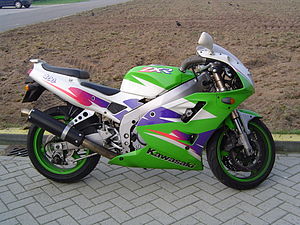 | |
| Manufacturer | Kawasaki |
|---|---|
| Parent company | Kawasaki Heavy Industries |
| Production | 1989–2003 (U.K) [clarification needed] |
| Successor | Kawasaki Ninja ZX-4R (2023) |
| Class | Sport bike |
| Engine | 398 cc (24.3 cu in) 16V DOHC liquid cooled inline 4 |
| Bore / stroke | 57 mm × 39 mm (2.2 in × 1.5 in) |
| Compression ratio | 12.1:1 |
| Top speed | 225 km/h (140 mph)[citation needed] |
| Power | H model 45.6 kW (61.2 hp) @ 12500 rpm[1] L model 47.8 kW (64.1 hp) @ 13000 rpm [2] |
| Torque | H model 39.2 N⋅m (28.9 lbf⋅ft) @ 10000 r/min (rpm)[1] L model 36.3 N⋅m (26.8 lbf⋅ft) @ 12000 rpm [2] |
| Ignition type | Battery and coil (transistorized) |
| Transmission | 6-speed, constant mesh, return shift |
| Frame type | Tubular, diamond |
| Suspension | Front Telescopic fork Rear: Uni-Trak swingarm |
| Brakes | Front Dual discs Rear Single disc |
| Tires | Front 120/60 VR17 Rear 160/60 VR17 |
| Rake, trail | 24°, 85 mm (3.3 in) |
| Wheelbase | 1,395 mm (54.9 in) |
| Dimensions | L: 1,995–2,035 mm (78.5–80.1 in) W: 700–705 mm (27.6–27.8 in) H: 1,125 mm (44.3 in) |
| Seat height | 760–765 mm (29.9–30.1 in) |
| Weight | H model 163 kg (359 lb),[1] L model 159 kg (351 lb)[citation needed] (dry) |
| Fuel capacity | 16 L (3.5 imp gal; 4.2 US gal) |
| Oil capacity | 3.0 L (0.66 imp gal; 0.79 US gal) |
| Turning radius | 3.2 m (10 ft) |
The Kawasaki ZXR400 is a sport bike introduced by Kawasaki in 1989. It was one of the most popular of the 400 cubic centimetres (24 cu in) sport bikes that swept across Japan and later Europe in the 1990s. It was discontinued in 1999 in worldwide markets but unsold models were imported to the United Kingdom until 2003.[clarification needed] The H model was produced first, and was superseded by the L series in 1991. The L series had increased power output, but less torque, and updated slimmer rear styling. An earlier model called the ZX-4 was released as a Japan only model from 1987-1988.
- ^ a b c Kawasaki Motors Corporation, Kawasaki ZXR400H Workshop Manual, 1990
- ^ a b zxr400world, "ZXR400 Technical specifications"